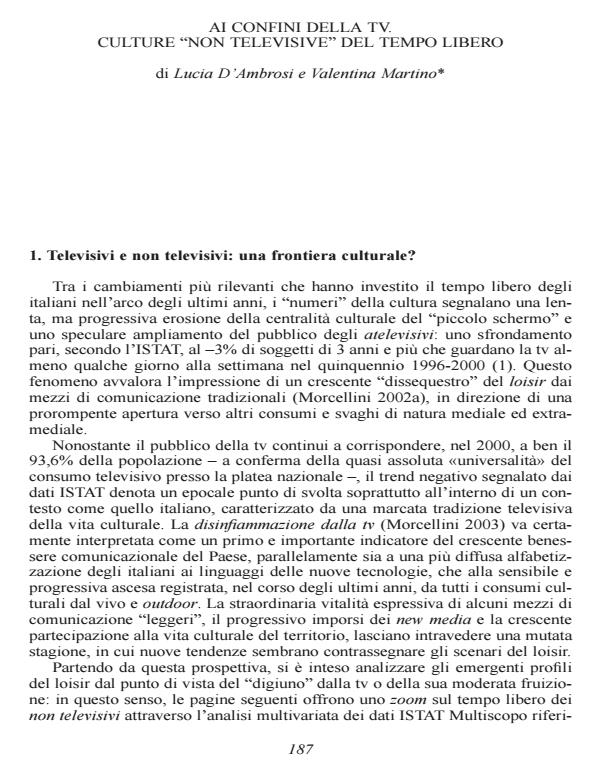Ai confini della tv. Culture non televisive del tempo libero
Titolo Rivista SOCIOLOGIA DELLA COMUNICAZIONE
Autori/Curatori Lucia D'Ambrosi, Valentina Martino
Anno di pubblicazione 2005 Fascicolo 2004/35-36
Lingua Italiano Numero pagine 17 P. Dimensione file 73 KB
DOI
Il DOI è il codice a barre della proprietà intellettuale: per saperne di più
clicca qui
Qui sotto puoi vedere in anteprima la prima pagina di questo articolo.
Se questo articolo ti interessa, lo puoi acquistare (e scaricare in formato pdf) seguendo le facili indicazioni per acquistare il download credit. Acquista Download Credits per scaricare questo Articolo in formato PDF

FrancoAngeli è membro della Publishers International Linking Association, Inc (PILA)associazione indipendente e non profit per facilitare (attraverso i servizi tecnologici implementati da CrossRef.org) l’accesso degli studiosi ai contenuti digitali nelle pubblicazioni professionali e scientifiche
The data show that TV has been slowly but progressively leaving its central place in the leisure time of Italian people in the years 1995-2000. The number of non-TV (a/ipoTV) members of the audience has been paralelly increasing. The proposed analysis, realised at the Osservatorio sul tempo libero - Dipartimento di Sociologia e Comunicazione - Università degli Studi La Sapienza, Rome has shown that the less cultured social areas are primarily moving away from TV, even if the reasons why the subjects are put in a more o less marginal place into the TV mainstreaming are more complex and often deeply heterogeneous. In this case a multivaried Istat Multiscopo data processing has been useful. In the first of the three specific TV clusters, moving away from TV seems to be only a residual condition towards a general lack of cultural opportunities and relational spurs in the leisure time. In the second group of subjects, the weak daily TV consumption is strictly complementary to a media mix of clear generalist mark, and to a position of the subjects in extremely active and full social webs. In the third cluster, finally, moving away from TV seems to be a natural way of finding a landingplace for very advanced multimedia paths, where low levels of TV consumption result crowned in a fully incremental way by the affiliation to the new technologies and interactivity languages.
Lucia D'Ambrosi, Valentina Martino, Ai confini della tv. Culture non televisive del tempo libero in "SOCIOLOGIA DELLA COMUNICAZIONE " 35-36/2004, pp , DOI: